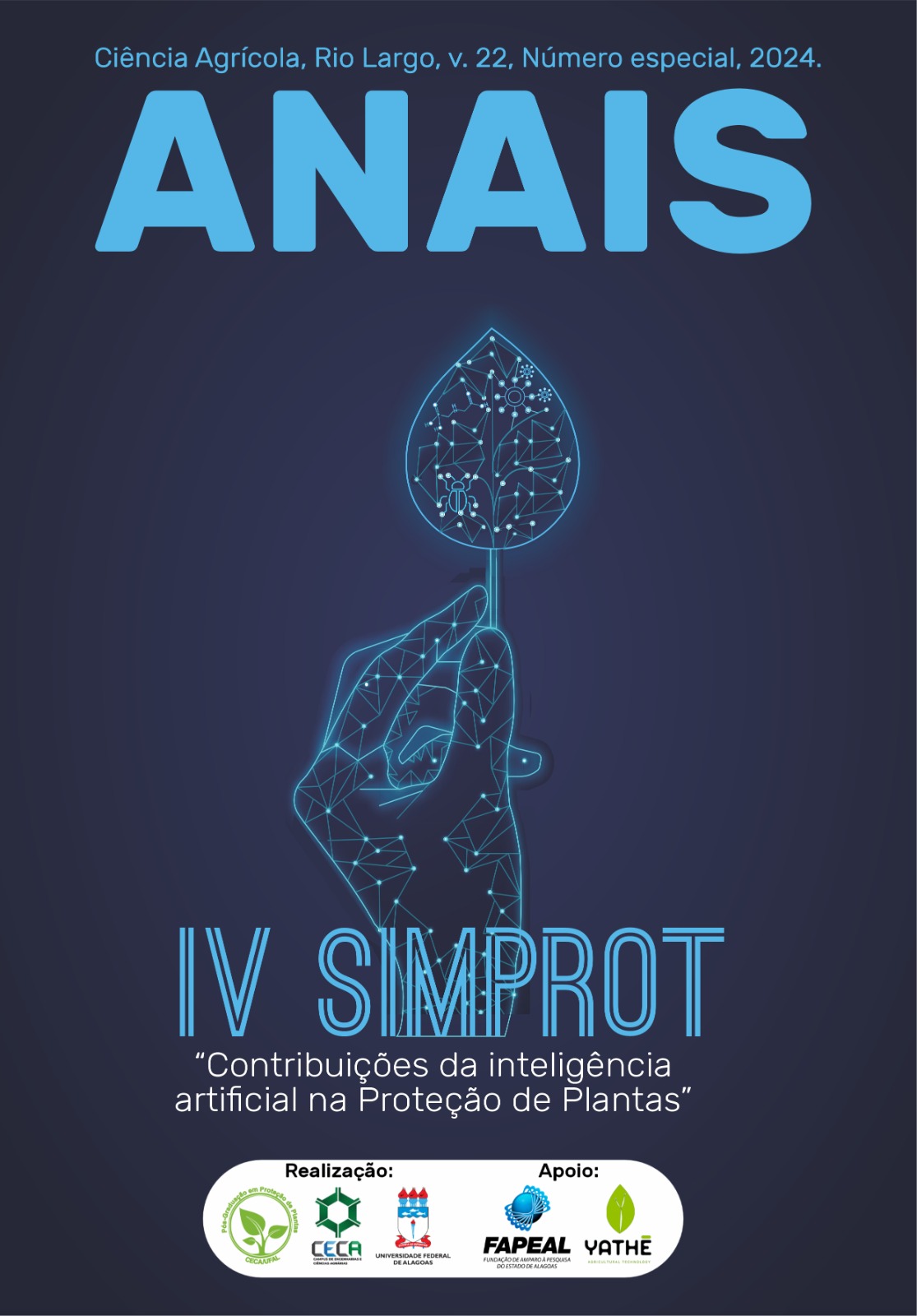LETHAL TOXICITY OF CITRONELLA ESSENTIAL OIL Cymbopogon nardus (POACEAE) ON THE GREEN CASSAVA MITE Mononychelus tanajoa (ACARI: TETRANYCHIDAE)
DOI:
https://doi.org/10.28998/rca.22.18601Keywords:
Alternative control, bioacaricide, lethal effectAbstract
The cassava green mite, Mononychelus tanajoa (Acari: Tetranychidae), is considered a key pest in cassava crops and the use of organosynthetic acaricides is the main form of control of this pest, which causes several environmental problems, such as selection of resistant populations, in addition to being non-selective. The search for alternative control methods is increasingly necessary to minimize such problems. Therefore, the objective of this work was to test the toxicity of citronella essential oil, Cymbopogon nardus (Poaceae), on M. tanajoa. Five treatments were used: 1.5; 2.5; 5.5 and 6.5μL, in addition to the control (water + 0.05% Tween) in a Petri dish containing a cassava leaf coated with a culture medium consisting of 10% water agar. On this agar layer, 5 discs were made in each Petri dish, which corresponded to the 5 replications of each treatment. The Petri dishes were sprayed with different essential oil treatments, using the Potter tower. After drying, ten M. Tanajoa females were inoculated in each arena. Mite mortality was verified after 24 hours and data was analyzed using the statistical program Sisvar version 5.6. The results demonstrated that concentrations of 1.5 and 2.5 μL/mL did not differ statistically from each other, however, they differed from the highest concentrations of 5.5 and 6.5 μL/mL. All concentrations tested showed a low mortality rate. The two highest concentrations controlled the mite, resulting in approximately 40% mortality. This demonstrates the need to adjust concentrations to achieve better effective control for M. tanajoa.
Downloads
References
AGROFIT. Disponível em: https ://www.não .g.br. Acesso em: 21 nov. 2024.
Caballero-Gallardo, K., Rodriguez-Niño, D., Fuentes-Lopez, K., Stashenko, E., & Olivero-Verbel, J. Chemical composition and bioactivity of essential oils from Cymbopogon nardus L. and Rosmarinus officinalis L. against Ulomoides dermestoides (Fairmaire, 1893)(Coleoptera: Tenebrionidae). Journal of Essential Oil Bearing Plants, 2021, 24, 3, 547-560.
El-Gendy, Hs; Shalaby, Am; El-Desouky, AI Atividade inseticida e repelente de óleos essenciais contra Tetranychus urticae e Tetranychus evansi. Revista de Entomologia Aplicada, 2022, 54, 38-47.
Foerster, L. A. Seletividade de inseticidas a predadores e parasitóides, p. 95-114. In: Parra, J. R. P. et al. (eds.), Controle biológico no Brasil: Parasitóides e predadores. São Paulo: Manole, 2002. 609 p.
Hutapea, D., Rahardjoa, I. B., & Thamrin, M. Prospects of neem and citronella oil against Pseudococcus longispinus (hemiptera: Pseudococcidae) on Phalaenopsis. In: IOP Conference Series: Earth and Environmental Science, 2021, 948, 1, 012088.
JAKUBOWSKA, M.; DOBOSZ, R.; ZAWADA, D. E.; KOWALSKA, J. A review of Tetranychus urticae Koch (Acari: Tetranychidae). Agricultura, v. 12, n. 7, 2024. Disponível em: https://doi.org/10.1/agri. Acesso em: 05 jan. 2024.
Moraes, G. J.; Flechtmann, C. H. W. Manual de acarologia: Acarologia básica e ácaros de plantas cultivadas no Brasil. Ribeirão Preto: Holos Editora, 2008. 308p.
NASCIMENTO, R. F.; OLIVEIRA, E. M.; SILVA, R. A. Mononychellus tanajoa em pr. Revista Brasileira de Entomologia, v. 67, p. 234-239, 2023
Saeed, S.; Khan, Ma; Abdullah, S. Ciência do manejo de pragas, v. 7
Santos, A. F. dos. Determinação da atividade anti-esquistossomótica de extratos e substâncias puras obtidas de plantas. 2005. Tese (Doutorado) – Instituto de Química e Biotecnologia, Universidade Federal de Alagoas.
Zamora, D., Klotz, S. A., Meister, E. A., & Schmidt, J. O. Repellency of the components of the essential oil, citronella, to Triatoma rubida, Triatoma protracta, and Triatoma recurva (Hemiptera: Reduviidae: Triatominae). Journal of medical entomology, 2015, 52, 4, 719-721.
Downloads
Published
Issue
Section
License
Copyright (c) 2024 Vitor França

This work is licensed under a Creative Commons Attribution 4.0 International License.
Termo de cessão de direitos autorias
Esta é uma revista de acesso livre, em que, utiliza o termo de cessão seguindo a lei nº 9.610/1998, que altera, atualiza e consolida a legislação sobre direitos autorais no Brasil.
O(s) autor(es) doravante designado(s) CEDENTE, por meio desta, cede o direito de primeira publicação da OBRA à Revista Ciência Agricola, representada pelo Centro de Ciência Agrarias da Universidade Federal de Alagoas, estabelecida na BR 104 Norte, Km 35, Rio Largo, Alagoas, CEP 57100-000 doravante designada CESSIONÁRIA, nas condições descritas a seguir:
O CEDENTE declara que é (são) autor(es) e titular(es) da propriedade dos direitos autorais da OBRA submetida.
O CEDENTE declara que a OBRA não infringe direitos autorais e/ou outros direitos de propriedade de terceiros, que a divulgação de imagens (caso as mesmas existam) foi autorizada e que assume integral responsabilidade moral e/ou patrimonial, pelo seu conteúdo, perante terceiros
O CEDENTE mantêm os direitos autorais e concedem à revista o direito de primeira publicação, com o trabalho simultaneamente licenciado sob a Licença Creative Commons do tipo atribuição CC-BY, para todo o conteúdo do periódico, exceto onde estiver identificado, que permite o compartilhamento do trabalho com reconhecimento da autoria e publicação inicial nesta revista, sem fins comerciais.
O CEDENTE têm autorização para distribuição não-exclusiva da versão do trabalho publicada nesta revista (ex.: publicar como capítulo de livro), com reconhecimento de autoria e publicação inicial nesta revista.
O CEDENTE têm permissão e são estimulados a publicar e distribuir seu trabalho online (ex.: em repositórios institucionais ou na sua página pessoal), já que isso pode gerar alterações produtivas, bem como aumentar o impacto e a citação do trabalho publicado.




